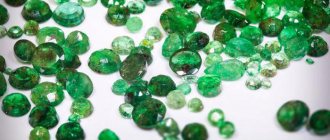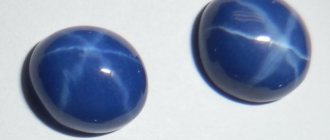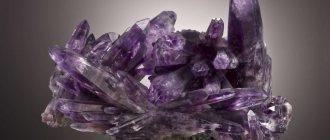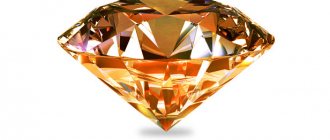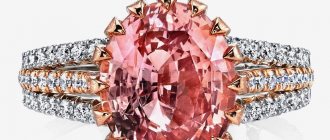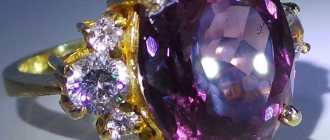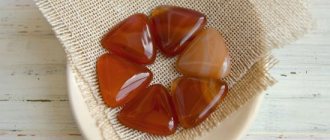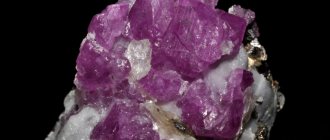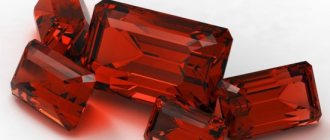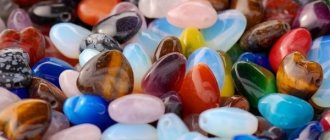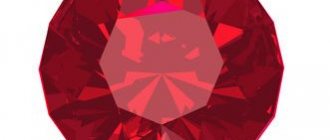Hydrothermal sapphire - what is it and how is it produced? It is known that such precious minerals as emeralds, sapphires and topazes already exist not only in nature. Modern technologies make it possible to grow them in laboratory conditions. This is exactly how hydrothermal sapphire is obtained, a stone that in its beauty can be no worse than natural.
What is hydrothermal sapphire
What is hydrothermal sapphire? This is a synthetic analogue of a naturally occurring mineral. It is obtained in specialized laboratories by synthesizing several chemical compounds under the influence of natural catalysts - pressure and temperature. While natural stone takes years to form, synthetic sapphire is produced in less than a month.
The chemical compounds that form the mineral are silicon dioxide, chromium and the main component is aluminum oxide. Afterwards, these elements are placed in a sealed apparatus, where they will be subjected to prolonged exposure to high temperatures (over 1000 ℃) and pressure.
Important! Hydrothermal sapphire (abbreviation gt) is not fake. It has the same physical and chemical properties as its natural counterpart. The difference is in the method of obtaining.
How to tell if a sapphire is natural or not
To distinguish an artificial crystal from a natural one, you need to pay attention to the following characteristics:
- The shimmer of the gem - a clear color indicates its synthetic origin.
- Natural corundum has an uneven glassy luster.
- Particular attention should be paid to the layers and faces of the mineral. When making fakes, craftsmen use the method of gluing stone particles together with crystal and colored epoxy resin. Upon careful inspection, these layers can be seen inside the stone. In addition, the edges of a fake can be smooth and soft - they are clear in a natural sapphire.
- Since the hardness of the mineral is very high, its edges will not have a worn, shabby appearance. The surface of real stone will be smooth without scratches.
- Examine the gem for the presence of various inclusions (cracks, any substances, air bubbles, gas, liquid). If they are present, you can confidently say that this is natural corundum. This is due to the fact that in the natural environment corundums are extremely rarely found completely pure - such stones have an extremely high cost. Typically, jewelry stores sell gems with various inclusions and a dull color, which has virtually no effect on their attractiveness.
- All synthetic analogues cannot have digital properties in terms of color and clarity of the stone. Such indicators can only be present on natural gems.
- Nano sapphires do not have hardness indicators similar to natural stones. The original cannot be scratched, but the artificial stone can.
- Synthetic gems cannot contain any cracks; only (in rare cases) spherical bubbles are possible.
- The color of the artificial stone is uneven, it contains curved stripes and different shades.
History of invention
For the first time, the French scientist Auguste Victor Louis Verneuil thought about the possibility of creating artificial precious stones. His journey of invention began in 1886 and lasted 16 long years. Only after this time did he announce the discovery and give comprehensive information about the results of the long experiment. He said that using high temperatures and the drop precipitation method, it is possible to obtain synthesized minerals, in particular blue corundum. Subsequently, this method became known as the Verneuil method. Afterwards, other scientists improved this method and created their own based on it. But for the first time, the discovered method is still successfully used in the chemical industry.
Signs of artificial sapphires
If it is necessary to change the shade of an already colored mineral, then the above-mentioned diffusion treatment of sapphire is used. But confuse this with declassed sapphires (low quality natural minerals).
Considering that the properties of stones obtained in the laboratory are identical to natural sapphires, it is difficult to distinguish them from each other. Natural stones are not big. Thus, the largest sapphire mined in the world weighs 280 g. And grown specimens reach 100-200 kg.
The presence of curved inclusions is another sign of an artificial mineral. This is what makes him different. However, this requires the trained eye of a jeweler. The jewelry is placed in a monobromonaphthalene solution and viewed under a magnifying glass against a white background.
If the stone is natural, then the streaks of inclusions will be straight. Artificially grown sapphire is distinguished by curved stripes. An experienced craftsman will notice small bubbles and the absence of microscopic cracks in synthetic nanocrystals.
Natural sapphires are characterized by whitish glare. There is no such effect in artificial minerals, and under an ultraviolet lamp they appear green.
Preparation method
Several options are currently used for the production of nanosapphires. One of them has already been described above, this is the Verneuil method. He laid the foundation for the development of other methods. What other methods exist:
- The Chorhalski method is based on drawing nanocrystals from the melt. It is formed by aluminum oxide, the main component. This technology is more advanced and allows you to obtain synthetic sapphires in a short time.
- Zone melting has two implementation options. Vertical and horizontal direction of movement of the heating element. As a result, a monolith of the grown mineral is formed.
- Star stones are produced by adding rutile to the standard “recipe”. Its addition occurs gradually by layering. The result is a specimen with the optical effect of asterism.
Interesting fact! The technology for producing synthetic stones with the effect of asterism was patented by an American company in 1949.
Compare prices
To be on the safe side and not get an imitation from another stone instead of a natural or laboratory-grown sapphire, you need to use an immersion liquid and a refractometer. For artificial and natural minerals the refractive index is the same, the coefficient ranges from 1.77-1.78.
Too low a price for sapphire should alert you. Natural blues sell for $200-$1000 per carat. Pink and orange minerals 100-130 each. The price of artificial blue corundum starts from 20 dollars per carat, and for pink it ranges from 5 to 8.
If you want to get acquainted with other blue minerals, read the article “Precious and semi-precious blue stones”.
Natural sapphire is second only to diamond in hardness, and only diamond is capable of leaving a scratch on it. Therefore, it is easiest to identify fakes made of blue glass. To do this, just scratch a “real” stone, and the difference will be obvious.
Continuing the topic, read the article “About natural and pressed turquoise: how to distinguish a fake.”
Types and colors of stone
Hydrothermal sapphires can come in a variety of colors, just like natural stones. To do this, chemical elements are added during the synthesis process to give the mineral a certain color. For example, colors in the blue and violet spectrum are achieved by using iron and titanium. Delicate pink and bright red specimens are obtained using vanadium or chromium. Sunny yellow shades are obtained by adding beryllium.
After the mineral has acquired the required color, in laboratory conditions it is possible to improve its external characteristics with additional exposure to external factors, such as:
- Ultraviolet radiation. Under UV rays, the color becomes richer and more noble.
- Hyperthermic effects. High temperatures (above 1500℃) can qualitatively change color. For example, a pink crystal will turn blue.
- The diffusion method involves the inclusion of chemical elements (for example, beryllium) under high pressure into the finished mineral. This is how optical effects are obtained.
About the pros and cons
The hydrothermal method also uses high temperatures. The essence is the pressure treatment of plates that are intended for seeding. The disadvantages of production include high material costs; accordingly, grown sapphire is expensive. But you can get specimens up to 300 kg.
The ability to manipulate colors is also unlimited. By introducing the addition of iron, beryllium and titanium, pink, yellow, orange and other tones are obtained.
However, the stone initially grows colorless. To ensure that the dye impregnation does not wash off, diffusion treatment at high temperatures is used. Any sapphire production plant works around the clock, as the process should not be interrupted.
The artificial mineral obtained in this way replicates natural sapphire in physical and optical properties. Moreover, the chemical composition and crystal structure are identical to the parameters of natural stones. The main advantage of grown gems is the absence of defects and richness of tones.
Recently, even gas transportation communications have been used to produce artificial sapphires. The search for new methods does not stop. New discoveries are replacing old ones, which, like the Verneuil method, are not distinguished by high quality products.
Properties and Application
The chemical properties of nano sapphire are practically no different from the original ones. The main structural element of corundum is aluminum oxide. The physical characteristics are also unchanged: hardness 9 out of 10 on the Mohs scale, density almost 4 g/cm3. Interacts with acids and dissolves in them. It has a glassy luster and a melting point of over 2000℃. This means that hydrothermal sapphire is no worse than natural sapphire. But the price is much more affordable.
The main area of application is the jewelry industry. However, other areas of industry also need artificial minerals: the aircraft industry, construction, the manufacture of magnifying instruments, cameras, collectible watches, etc.
Parameters of natural stones
Sapphires are minerals that, due to their high prices, have always been sought to be created artificially. Natural stone has high transparency and hardness (9 units), a glassy sparkling luster, and a density of up to 4 g per cubic meter. see Refers to corundum with the chemical formula Al2O3.
Minerologists recognize only cornflower blue sapphires. Jewelers work with any shades. Available colors:
- blue in light and dark tones;
- orange;
- yellow;
- violet;
- green;
- black;
- pink;
- colorless.
The presence of air bubbles makes the crystal cloudy (milky). Read more about the qualities of the mineral in the article “Properties of sapphire stone and who it is suitable for.”
Advantages and disadvantages
Grown sapphire is characterized by:
- Clean structure without foreign inclusions and cracks.
- UV resistant.
- Large stones are usually of artificial origin.
- Color saturation and uniformity.
- A cost that is significantly lower than that of natural stones.
There are some disadvantages that characterize nano sapphire:
- There may be micro-bubbles of air in the structure.
- Some stones have a pronounced “growth line” of the crystal.
Properties of nano sapphires
Like any other gems, nanosapphires are also credited with a variety of mystical and even medicinal properties.
Medicinal
It is believed that such sapphire will be useful in therapy:
- heart disease, kidney disease;
- asthma;
- urinary disorders;
- nervous disorders;
The stone has a beneficial effect on the human immune system, which has a positive effect on the functioning and condition of all internal organs and systems.
Magical
Sapphire has a number of magical properties. Astrologers and magicians claim that the stone attracts prosperity, happiness, and true love to its owner. It will help a person direct his energy in the right direction, find a life goal, and make the owner bolder and more purposeful. The powerful energy of sapphire will pacify a hot-tempered, impulsive disposition. The stone makes its owner calm, sane and gives him spiritual balance.
Corundum acts as a strong amulet against black magic, protects against the evil eye, damage, and any troubles. If a person was unsure of his abilities, shy, sapphire will help him overcome fears, complexes and achieve success.
The gem draws cosmic energy, which strengthens it and emphasizes the strong characteristics of the owner, protecting him from failures. The stone opens up opportunities for a person to realize his creative potential. It gives clarity of thought, allows you to look at yourself from the outside, and develop your inner world. Sapphire will be useful for people who cannot concentrate and face difficulties in learning something new.
Care
Jewelry with hydrothermal stones, full-fledged analogues of natural ones, require the same care and compliance with storage rules. To preserve the beauty and shine of a product with a synthesized mineral for a longer period of time, you must:
- avoid contact with cosmetics, sprays, household chemicals
- remove before swimming in the sea, visiting the pool
- store separately
- wipe with a soft cloth, wash in a mild soap solution, do not use brushes with a rough surface
